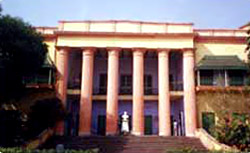Uttarpara is a small town of Hoogly district, West Bengal India. Uttarpara is located in south -eastern tip of Hoogly district; on the bank of river Ganga has a historical significance. It is situated just across the famous Dakshineswar Temple. In Bengali language Uttarpara means `North Side`.
History
In the year 1704 AD, a Zamindar of famous Sabarnya Chowdhury clan, Shri Ratneswar Rai Chowdhury left his ancestral village near Barrackpur of 24 pargans district for a new residence in Uttarpara, which was at that time was spelled as Ootarpara on the bank of river Hooghly. In those days, village Ootarpara was northern part of village Bally.
During the period of 1800-1900 AD, this tiny village was gradually turned to a small town of 0.8 sq. mile with the help of Ramhari Roy, great grandson of Ratneswar Roy Chowdhury.
In the year 1894 Uttarpara came under Hoogly District and Uttarpara Municipality was formed on 14th April 1853.
Geography
The geographical location of Uttarpara is 22°.40N latitude and 88°.22 longitude. The western side of Uttarpara is bounded by Khorel city, north by Kornnagar, Kotrung, east by Agar Para and Kamarhati and southern side by Bali and Baranagar. It has a tropical savanna climate. The maximum temperature is 38°C and minimum is 26°C.The average annual fall is 1,500mm. It is situated on the bank of the river Ganga.
Economy
Uttarpara is home to India`s first car factory, Hindustan Motors. It is a part of the Birla group of Industries, people are mostly depends on the industries. It is the producer of the famous Ambassador car. It was founded in 1942. Hindustan has joint venture with Mitsubishi, producing versions of the Lancer and Pajero, but is best known for its own models.
Shalimar wire products and Shaw Wallace are the two other famous industries of Uttarpara.
Government and Politics
Uttarpara Municipality has a Chairman to control over the city.
Transport
By Air: Kolkata Airport is the nearest airport to Uttarpara.
By Rai: The railway station of Uttarpara is well connected with Howrah.
By Road: The prime road of India, the Grand Trunk Road is passes through Uttarpara. The city is well connected with the entire major other cities of West Bengal by road.
Demographics
As per 2001 census, Uttarpara had a population of 150,204. Male constitutes 52% and the female constitute of 48% of the total population. 8% of the population is under six year of age. Uttarpara has an average literacy rate of 79%, higher than the national average literacy rate of 59.5%. Male literacy rate is 82% and the female literacy is 76%.
Culture
 Uttarpara boasts of a rich cultural heritage. Philanthropic Zamindaar of Bengal, Sri Joy Krishna Mukharji contributed a library, public hospital and a school. This Jay Krishna Library is the first library of India.
Uttarpara boasts of a rich cultural heritage. Philanthropic Zamindaar of Bengal, Sri Joy Krishna Mukharji contributed a library, public hospital and a school. This Jay Krishna Library is the first library of India.
To promote and propagate Indian classical music the local people with senior music lovers built Uttarpara Sangeet Chakra in the year 1956.
Uttarpara cherishes a special association with Sri Aurobindo. At the time of celebrating his birth century celebration, few eminent citizens of Uttarpara decided to set up an organization dedicated to Sri Aurobindo, which they named as Sri Aurobindo Parishad. This committee is engaged in generating and sustaining public awareness about the life, works and the Philosophy of Sri Aurobindo.
Uttarpara Journal Association, later renamed as Uttarpara Pathagar, which was established in the year 1935. This library started with its unique purpose of catering only journals for imparting current and up-to-date knowledge to the readers.
Uttarpara Abakash is a ladies voluntary social welfare organization was established on 11th January 1981 with the aim to serve the distressed, diseased and handicapped section of the society.
Durga Puja and Deepavali or Kali puja are the main festivals of Uttarpara.
The other festivals are: -
Naba Barasho- It is the celebration of Bengali New Year in the month of Baisakh (mid April).
Ratha Yatra- It is held in the month of June-July. In this festival Lord Jagannath, Subhadra and Balram are sitting on the chariot for a journey.
Visiting places of Uttarpara
Muktakeshi Kali Temple- This temple was built by Sabarna Rai Chowdhury`s family 300 years ago. This temple is situated just opposite of the DakshineshwarTemple.
Mandirbari Temple- This famous Kali temple is situated in the Mandirbari Ghat.
Shiv Temple- Near Mandirbari Ghat there are300 years of old three sets of Shiv temples are situated.
Education
The following are the famous educational Institutions of Uttarpara.
| Raja Pyari Mohan College. |
Amarendra Vidyapith. |
Deviswari Vidya Niketan. |
Children`s own Home. |
| Uttarpara Govt. High School. |
Uttarpara Girl`s High School. |
Bhadrakali School. |
|
More on west Bengal
 Uttarpara boasts of a rich cultural heritage. Philanthropic Zamindaar of Bengal, Sri Joy Krishna Mukharji contributed a library, public hospital and a school. This Jay Krishna Library is the first library of India.
Uttarpara boasts of a rich cultural heritage. Philanthropic Zamindaar of Bengal, Sri Joy Krishna Mukharji contributed a library, public hospital and a school. This Jay Krishna Library is the first library of India.



















